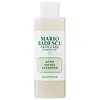What's inside
What's inside
 Key Ingredients
Key Ingredients

 Benefits
Benefits

 Concerns
Concerns

 Ingredients Side-by-side
Ingredients Side-by-side

Water
Skin ConditioningGlycerin
HumectantTriethanolamine
BufferingSodium Laureth Sulfate
CleansingPropylene Glycol
HumectantIsopropyl Alcohol
SolventSalicylic Acid
MaskingDimethicone
EmollientAloe Barbadensis Leaf Juice
Skin ConditioningChamomilla Recutita Flower Extract
MaskingThymus Vulgaris Leaf Extract
Skin ProtectingSodium Hyaluronate
HumectantCarbomer
Emulsion StabilisingParfum
MaskingDiazolidinyl Urea
PreservativeMethylparaben
PreservativePropylparaben
PreservativeBenzyl Benzoate
AntimicrobialBenzyl Salicylate
PerfumingEugenol
PerfumingLinalool
PerfumingWater, Glycerin, Triethanolamine, Sodium Laureth Sulfate, Propylene Glycol, Isopropyl Alcohol, Salicylic Acid, Dimethicone, Aloe Barbadensis Leaf Juice, Chamomilla Recutita Flower Extract, Thymus Vulgaris Leaf Extract, Sodium Hyaluronate, Carbomer, Parfum, Diazolidinyl Urea, Methylparaben, Propylparaben, Benzyl Benzoate, Benzyl Salicylate, Eugenol, Linalool
Water
Skin ConditioningPhytelephas Aequatorialis Seed Powder
Propylene Glycol
HumectantCarbomer
Emulsion StabilisingSodium Laureth Sulfate
CleansingTriethanolamine
BufferingCamellia Sinensis Leaf Extract
AntimicrobialCocos Nucifera Fruit Extract
EmollientGinkgo Biloba Leaf Extract
Skin ConditioningZingiber Officinale Root Extract
MaskingAloe Barbadensis Leaf Juice
Skin ConditioningCaprylyl Glycol
EmollientHexylene Glycol
EmulsifyingPhenoxyethanol
PreservativeParfum
MaskingWater, Phytelephas Aequatorialis Seed Powder, Propylene Glycol, Carbomer, Sodium Laureth Sulfate, Triethanolamine, Camellia Sinensis Leaf Extract, Cocos Nucifera Fruit Extract, Ginkgo Biloba Leaf Extract, Zingiber Officinale Root Extract, Aloe Barbadensis Leaf Juice, Caprylyl Glycol, Hexylene Glycol, Phenoxyethanol, Parfum
Ingredients Explained
These ingredients are found in both products.
Ingredients higher up in an ingredient list are typically present in a larger amount.
Aloe Barbadensis Leaf Juice comes from leaves of the aloe plant. Aloe Barbadensis Leaf Juice is best known for helping to soothe sunburns. It is also anti-inflammatory, moisturizing, antiseptic, and can help heal wounds.
Aloe is packed with good stuff including Vitamins A, C, and E. These vitamins are antioxidants, which help fight free-radicals and the damage they may cause. Free-radicals are molecules that may damage your skin cells, such as pollution.
Aloe Barbadensis Leaf Juice also contains sugars. These sugars come in the form of monosaccharides and polysaccharides, folic acid, and choline. These sugars are able to help bind moisture to skin.
It also contains minerals such as calcium, 12 anthraquinones, fatty acids, amino acids, and Vitamin B12.
Learn more about Aloe Barbadensis Leaf JuiceCarbomer is a polymer of acrylic acid. Its main role is to create a gel consistency.
A high amount of carbomer can cause pilling or balling up of products. Don't worry, most products contain 1% or less of carbomer.
Parfum is a catch-all term for an ingredient or more that is used to give a scent to products.
Also called "fragrance", this ingredient can be a blend of hundreds of chemicals or plant oils. This means every product with "fragrance" or "parfum" in the ingredients list is a different mixture.
For instance, Habanolide is a proprietary trade name for a specific aroma chemical. When used as a fragrance ingredient in cosmetics, most aroma chemicals fall under the broad labeling category of “FRAGRANCE” or “PARFUM” according to EU and US regulations.
The term 'parfum' or 'fragrance' is not regulated in many countries. In many cases, it is up to the brand to define this term.
For instance, many brands choose to label themselves as "fragrance-free" because they are not using synthetic fragrances. However, their products may still contain ingredients such as essential oils that are considered a fragrance by INCI standards.
One example is Calendula flower extract. Calendula is an essential oil that still imparts a scent or 'fragrance'.
Depending on the blend, the ingredients in the mixture can cause allergies and sensitivities on the skin. Some ingredients that are known EU allergens include linalool and citronellol.
Parfum can also be used to mask or cover an unpleasant scent.
The bottom line is: not all fragrances/parfum/ingredients are created equally. If you are worried about fragrances, we recommend taking a closer look at an ingredient. And of course, we always recommend speaking with a professional.
Learn more about ParfumPropylene Glycol is an odorless, colorless liquid. As a humectant, it helps skin retain moisture. It also aids in delivering active ingredients.
Another role of this ingredient is preventing a product from melting or freezing. Propylene glycol also adds antimicrobrial properties to a product, elongating product lifespan.
This ingredient is considered an organic alcohol and commonly added into both cosmetics and foods.
Those with sensitive skin or conditions may develop a rash when using this ingredient.
Learn more about Propylene GlycolSodium Laureth Sulfate (SLES) is a foaming, cleansing, and emulsifying ingredient. It is created from palm kernel oil or coconut oil. SLES is not the same as sodium lauryl sulfate. It is much milder and less likely to irritate.
SLES helps create foam in personal products. It also prevents ingredients from separating, helping to elongate the shelf life.
Sodium Laureth Sulfate is a type of sulfate. It can be drying. We recommend speaking with a professional about using this ingredient if you have concerns.
Learn more about Sodium Laureth SulfateTriethanolamine is an emulsifier and pH adjuster. It is created using ethylene oxide and ammonia. This gives Triethanolamine a nitrogen core and a similar scent to ammonia.
As an emulsifier, it prevents ingredients from separating and enhances texture by adding volume to a product.
PH adjusters are common in cosmetic products. The pH of a product can affect the effectiveness of other ingredients. A product with a high pH may also irritate the skin.
Learn more about TriethanolamineWater. It's the most common cosmetic ingredient of all. You'll usually see it at the top of ingredient lists, meaning that it makes up the largest part of the product.
So why is it so popular? Water most often acts as a solvent - this means that it helps dissolve other ingredients into the formulation.
You'll also recognize water as that liquid we all need to stay alive. If you see this, drink a glass of water. Stay hydrated!
Learn more about Water